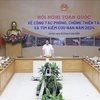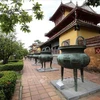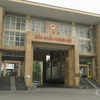Smog has filled the air in central Hanoi during the past three days, but experts cannot agree on its origin or cause.
Le Thanh Dung, who lives with her family on Kim Ma street in Ba Dinh district, said that even after she closed all the windows and doors on the night of July 5, "we still felt our eyes smart, and our small daughter kept coughing".
Pham Thu Trang, a resident of Thanh Xuan district, said she also encountered smog with a burnt smell when she went out on the same night.
Trang added that on July 4 she went to her hometown in Thanh Tri district and saw local farmers burning dozens of piles of straw along the sides of the roads.
"The smoke from the burnt straw was so dark that I had to turn on my motorbike's headlight even though it was eight o'clock in the morning," she said.
Trang guessed that the smoke from their fires traveled over to central Hanoi .
Pham Van Khanh, deputy director of the Hanoi Department of Natural Resources and Environment, agreed that the smog was indeed caused by burnt straw in certain suburbs of the city.
This phenomenon has occured several times in the past 10 years, especially in hot weather, he said, and not only in Vietnam but also in Japan and Australia .
"The heat prevents smoke from drifting upwards and instead it moves laterally, staying low to the ground," he said.
But some other experts believe the smog is a product of environmental pollution, caused by photochemicals in the atmosphere.
Chairman of the Thanh Tri district People's Committee Nguyen Quang Hieu said that most of the farmers in his district used straw to make fertiliser and did not burn it.
If the smog were caused by burnt straw, he said, it would cover tree leaves and household appliances with soot.
Hanoi 's many tall buildings prevent air circulation, but harmful exhaust fumes from vehicles and industrial zones were behind the photochemical smog.
Nguyen Huu Hai of the National Centre for Hydro-Meteorological Forecastsing agreed with Hieu's reasoning.
Hot air enters the country from the west at the height of 3,000 metres and pollutants collect underneath, said Hai.
This harmful smog could cause optical and cardiovascular diseases, he said.
"Families can turn on fans or air-conditioners to blow away the smog, but in the long term we should treat exhaust fumes to improve the air quality," said Hai./.
Le Thanh Dung, who lives with her family on Kim Ma street in Ba Dinh district, said that even after she closed all the windows and doors on the night of July 5, "we still felt our eyes smart, and our small daughter kept coughing".
Pham Thu Trang, a resident of Thanh Xuan district, said she also encountered smog with a burnt smell when she went out on the same night.
Trang added that on July 4 she went to her hometown in Thanh Tri district and saw local farmers burning dozens of piles of straw along the sides of the roads.
"The smoke from the burnt straw was so dark that I had to turn on my motorbike's headlight even though it was eight o'clock in the morning," she said.
Trang guessed that the smoke from their fires traveled over to central Hanoi .
Pham Van Khanh, deputy director of the Hanoi Department of Natural Resources and Environment, agreed that the smog was indeed caused by burnt straw in certain suburbs of the city.
This phenomenon has occured several times in the past 10 years, especially in hot weather, he said, and not only in Vietnam but also in Japan and Australia .
"The heat prevents smoke from drifting upwards and instead it moves laterally, staying low to the ground," he said.
But some other experts believe the smog is a product of environmental pollution, caused by photochemicals in the atmosphere.
Chairman of the Thanh Tri district People's Committee Nguyen Quang Hieu said that most of the farmers in his district used straw to make fertiliser and did not burn it.
If the smog were caused by burnt straw, he said, it would cover tree leaves and household appliances with soot.
Hanoi 's many tall buildings prevent air circulation, but harmful exhaust fumes from vehicles and industrial zones were behind the photochemical smog.
Nguyen Huu Hai of the National Centre for Hydro-Meteorological Forecastsing agreed with Hieu's reasoning.
Hot air enters the country from the west at the height of 3,000 metres and pollutants collect underneath, said Hai.
This harmful smog could cause optical and cardiovascular diseases, he said.
"Families can turn on fans or air-conditioners to blow away the smog, but in the long term we should treat exhaust fumes to improve the air quality," said Hai./.



















